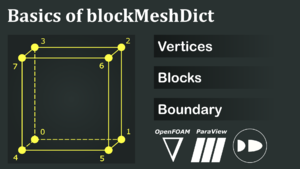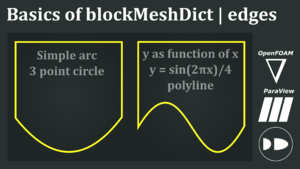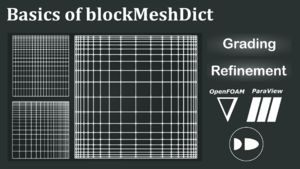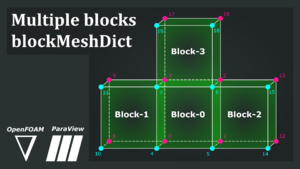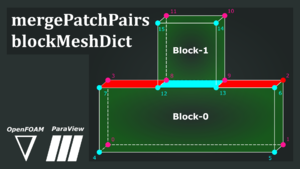Difference between revisions of "BlockMesh by Divyesh Variya (DD Fluids)"
m |
|||
| (One intermediate revision by the same user not shown) | |||
| Line 7: | Line 7: | ||
* '''YouTube channel''': [https://www.youtube.com/c/DDFluids/ DDFluids] | * '''YouTube channel''': [https://www.youtube.com/c/DDFluids/ DDFluids] | ||
* '''LinkedIn Profile''': [https://www.linkedin.com/in/divyeshvariya/ DivyeshVariya] | * '''LinkedIn Profile''': [https://www.linkedin.com/in/divyeshvariya/ DivyeshVariya] | ||
| + | |||
| + | Go back to [https://wiki.openfoam.com/Meshing_in_OpenFOAM_by_Divyesh_Variya_(DD_Fluids) Meshing by Divyesh Variya]. | ||
| + | |||
| + | Go back to [https://wiki.openfoam.com/Day_6 Day 6 of 3-week series]. | ||
=blockMesh= | =blockMesh= | ||
| + | |||
| + | The blockMesh is a very simple and powerful tool or utility of OpenFOAM to create simple 1D/2D/3D geometries and mesh it. In this tutorial series, a detailed overview is given using a lid-driven cavity case. | ||
| + | |||
| + | All major sections of blockMeshDict are discussed with different hands-on modifications. In addition, an explanation of the sub-section edges & mergePatchPair of blockMeshDict is explained in these tutorials. How one can create an arc and polyline using edges section and merge two blocks using mergePatchPair section is discussed with hands-on modifications. Additionally, this tutorial describes how one can create finer mesh near a particular face in blockMeshDict, simple grading is used. | ||
==blockMeshDict [vertices|blocks|boundary]== | ==blockMeshDict [vertices|blocks|boundary]== | ||
| − | [[File:vertices_blockMesh_Divyesh.png| | + | [[File:vertices_blockMesh_Divyesh.png|300px|thumb|left]] |
Tutorial link: [https://youtu.be/4l2em9Lhp5A YouTube Tutorial] | Tutorial link: [https://youtu.be/4l2em9Lhp5A YouTube Tutorial] | ||
| − | Description: A detailed overview explained in this tutorial using a lid driven cavity case. The three major sections of blockMeshDict are discussed with different hands on modifications. | + | Description: A detailed overview explained in this tutorial using a lid-driven cavity case. The three major sections of blockMeshDict are discussed with different hands-on modifications. |
Points covered: | Points covered: | ||
* How to define vertices | * How to define vertices | ||
* How to define block | * How to define block | ||
| − | * How to | + | * How to discretize a domain |
* How to define physical boundaries | * How to define physical boundaries | ||
* How to scale geometry | * How to scale geometry | ||
| Line 27: | Line 35: | ||
==blockMeshDict [edges]== | ==blockMeshDict [edges]== | ||
| − | [[File:edges_blockMesh_Divyesh.png| | + | [[File:edges_blockMesh_Divyesh.png|300px|thumb|left]] |
Tutorial link: [https://youtu.be/OMBSNGWKIMU YouTube Tutorial] | Tutorial link: [https://youtu.be/OMBSNGWKIMU YouTube Tutorial] | ||
| − | Description: An | + | Description: An explanation of sub-section edges of blockMeshDict is explained in this tutorial. How one can create an arc and polyline using the edges section is discussed with hands-on modifications. |
Points covered: | Points covered: | ||
| Line 42: | Line 50: | ||
==blockMeshDict [simpleGrading]== | ==blockMeshDict [simpleGrading]== | ||
| − | [[File:simpleGrading_blockMesh_Divyesh.png| | + | [[File:simpleGrading_blockMesh_Divyesh.png|300px|thumb|left]] |
Tutorial link: [https://youtu.be/RKDia8Xjtu8 YouTube Tutorial] | Tutorial link: [https://youtu.be/RKDia8Xjtu8 YouTube Tutorial] | ||
| − | Description: To create finer mesh near a | + | Description: To create finer mesh near a particular face in blockMeshDict, simple grading is used. In this tutorial, few options of simpleGrading are explained for example, how to create a finer grid near a single face and two faces. |
Points covered: | Points covered: | ||
| − | * How to create finer grid near a face | + | * How to create a finer grid near a face |
* How to distribute geometry and no. of cells | * How to distribute geometry and no. of cells | ||
* How expansion ratio work in blockMeshDict | * How expansion ratio work in blockMeshDict | ||
| + | |||
| + | |||
| + | ==blockMeshDict [Multiple blocks]== | ||
| + | |||
| + | [[File:Multiblock blockMesh Divyesh.png|300px|thumb|left]] | ||
| + | |||
| + | Tutorial link: [https://youtu.be/tSXyZmfVaX4 YouTube Tutorial] | ||
| + | |||
| + | Description: This video tutorial covers how to define multiple blocks for slightly complex geometries in blockMeshDict. For demonstration, T-shape geometry is created and four blocks have been added. For better understanding try to add one more block below and make a "plus" shape geometry by yourself. | ||
| + | |||
| + | Points covered: | ||
| + | * How to add vertices for extra blocks | ||
| + | * How to add multiple blocks | ||
| + | * Tip-1: Always sketch your geometry first | ||
| + | * Challenge: Add one more block and create "plus" shape geometry | ||
| + | |||
| + | |||
| + | ==blockMeshDict [mergePatchPair]== | ||
| + | |||
| + | [[File:mergePatchPair blockMesh Divyesh.png|300px|thumb|left]] | ||
| + | |||
| + | Tutorial link: [https://youtu.be/h4IpEI9uA_Q YouTube Tutorial] | ||
| + | |||
| + | Description: This video tutorial explains when and how to use the mergePatchPair function in the blockMeshDict file. Using two blocks we can create a T-shape geometry where two separate blocks will merge into one. | ||
| + | |||
| + | Points covered: | ||
| + | * How to add vertices for extra blocks | ||
| + | * How to add multiple blocks | ||
| + | * How to define patches in mergePatchPair | ||
Latest revision as of 12:49, 27 May 2021
- contributor: Divyesh Variya
- affiliation: Indian Institute of Technology, Bombay
- contact: click here for email address
- OpenFOAM versions: v2012
- Published under: CC BY-NC-SA license (creative commons licenses)
- YouTube channel: DDFluids
- LinkedIn Profile: DivyeshVariya
Go back to Meshing by Divyesh Variya.
Go back to Day 6 of 3-week series.
Contents
blockMesh
The blockMesh is a very simple and powerful tool or utility of OpenFOAM to create simple 1D/2D/3D geometries and mesh it. In this tutorial series, a detailed overview is given using a lid-driven cavity case.
All major sections of blockMeshDict are discussed with different hands-on modifications. In addition, an explanation of the sub-section edges & mergePatchPair of blockMeshDict is explained in these tutorials. How one can create an arc and polyline using edges section and merge two blocks using mergePatchPair section is discussed with hands-on modifications. Additionally, this tutorial describes how one can create finer mesh near a particular face in blockMeshDict, simple grading is used.
blockMeshDict [vertices|blocks|boundary]
Tutorial link: YouTube Tutorial
Description: A detailed overview explained in this tutorial using a lid-driven cavity case. The three major sections of blockMeshDict are discussed with different hands-on modifications.
Points covered:
- How to define vertices
- How to define block
- How to discretize a domain
- How to define physical boundaries
- How to scale geometry
blockMeshDict [edges]
Tutorial link: YouTube Tutorial
Description: An explanation of sub-section edges of blockMeshDict is explained in this tutorial. How one can create an arc and polyline using the edges section is discussed with hands-on modifications.
Points covered:
- How to create a curved face
- How to create 3 point arc
- How to create a polyline
- How to create finer and smoother face
- How to add points from excel to blockMeshDict
blockMeshDict [simpleGrading]
Tutorial link: YouTube Tutorial
Description: To create finer mesh near a particular face in blockMeshDict, simple grading is used. In this tutorial, few options of simpleGrading are explained for example, how to create a finer grid near a single face and two faces.
Points covered:
- How to create a finer grid near a face
- How to distribute geometry and no. of cells
- How expansion ratio work in blockMeshDict
blockMeshDict [Multiple blocks]
Tutorial link: YouTube Tutorial
Description: This video tutorial covers how to define multiple blocks for slightly complex geometries in blockMeshDict. For demonstration, T-shape geometry is created and four blocks have been added. For better understanding try to add one more block below and make a "plus" shape geometry by yourself.
Points covered:
- How to add vertices for extra blocks
- How to add multiple blocks
- Tip-1: Always sketch your geometry first
- Challenge: Add one more block and create "plus" shape geometry
blockMeshDict [mergePatchPair]
Tutorial link: YouTube Tutorial
Description: This video tutorial explains when and how to use the mergePatchPair function in the blockMeshDict file. Using two blocks we can create a T-shape geometry where two separate blocks will merge into one.
Points covered:
- How to add vertices for extra blocks
- How to add multiple blocks
- How to define patches in mergePatchPair
